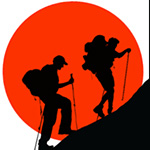Going on a Backpacking Trip?
But Hey, How well do you know your Backpack?
Here's all you need to know about the various types of Rucksacks, their Size and Features. This guide will get you ready to plunge in and start your Trekking and Backpacking Adventure like a pro!
Rucksack Type & Size Guide
Day Sacks: (up to 25 litres)
Day Sacks are big enough to carry a few items for summer walking, such as a map, compass, food and drink, penknife, simple first aid/ blister kit, camera, etc. They usually have a simple, lightweight carrying system, with little or no padding or stiffening in the back and plain shoulder straps.
Climbing Day Sacks (up to 20 to 45 litres)
Because of the need to carry a number of fairly bulky items these sacks usually have a single compartment with an additional lid pocket. Compression/accessory straps are useful for carrying extra equipment to the base of a route, and for reducing the size of the sack to keep the weight close to the wearer’s back when climbing. Twin Ice axe carrying loops and crampon patches are necessary for Alpine or winter climbing. The back systems are fairly simple, probably with basic padding and support.
Larger Walking / Backpacking Sacks
If staying overnight in a youth hostel or bed and breakfast a little extra equipment is needed, as well as some extra food, so a 45 to 65 litres sack should be used. For backpacking a tent, sleeping bag, stove, food, fuel, etc., will be carried, a sack of 65 to 75 litres is generally regarded as the best size. Remember that for winter use increased space and additional features may be required. The extra weight being carried means that a stiffened back is needed for the sack to be a comfortable shape. A more sophisticated carrying system is used to transfer much of the weight to the hips to reduce excessive loading on the shoulders and down the spine. These sacks will often have two main compartments, although the dividing shelf may be removable to enable the sack to be used as a single compartment sack.
Large Mountaineering Sacks (up to 70 to 85 litres)
For scrambling, non-technical snow climbing, glacier crossing, or ski-mountaineering, rucksacks are made with a combination of features from both climbing and backpacking sacks. They are designed for carrying big loads on the fairly easy ground so they have a backpacking style carrying system whereby much of the weight is taken on the hips rather than the shoulders. Generally, they have a choice of single or double main compartment with a removable divider, combined with a compressible side pocket system and some form of an extension to the main compartment, which gives them the option of large carrying capacity. The straight sides, compression/accessory straps, and a multiple ice axe and crampon attachment straps are useful for carrying big loads on the fairly easy ground on expeditions, etc.
Rucksack Features

1 Shoulder Harness
2 Daisy Chain (for Chest Harness)
3 Top Tension Straps
4 Haul Loop
5 Lumbar Pad
6 Padded Waist Belt
7 Chest Strap
8 Integral Frame
9 Compression Straps
10 Main Compartment
11 Dividing Section
12 Fixed Pocket
13 Accessory Patches
14 Profile Straps
15 Map Pocket
16 Ice Axe Loops
17 Lid
Main Compartment:
This is used to carry the majority of equipment and is loaded from the top and is partially closed by a drawcord, with the lid providing a weatherproof seal. Many of these rucksacks are extendible (i.e. the lid can be raised and the snow lock used for storage of extra gear) which can be useful for transporting extra equipment to a fixed campsite, or to the foot of a climbing route.
Base Compartment:
Accessed by a zipped entry, it may have compression straps to hold soft items such as sleeping bags securely. The “shelf” dividing the main and base compartments can often be removed by means of zip of drawcord to give the option of one large compartment.
Loading Straps:
Compression/Accessory straps are those which run around the sides of a rucksack and are used to compress it so that the weight is held close to your back when the sack is partially full. They also allow additional side pockets to be fitted to give extra space, or they can be used for attaching excess gear (sleeping bag mats, skis, tent poles, fishing rod, snow shovel, etc.)
Closure/ Profile Straps run vertically around the sack. At their top end, they are used to hold the lid closed, but at the base, there may be extra buckles that can be used to reduce the width of the base of the sack.
Pockets:
The lid pocket is useful for carrying items that are most frequently needed when on the move, as the zip entry is usually behind the neck where it can just be reached. Care is needed, however, to ensure that small items do not fall out of the pocket when it is opened. If travelling with a companion it may be better to use the side pockets, as your companion will be able to reach into these without you needing to take off the rucksack. They can also be used for fuel bottles and things that may contaminate other gear.
Accessory Patches:
Used to strap larger items to the outside of the pack (Such as tent poles etc)
Lid:
Usually elasticized around the edges for a more weatherproof seal and held closed by snap-fit buckles on the profile straps. On most sacks, the lid is stitched down on the side next to the wearer’s back, but on others, it is held by straps all around. This enables the lid to be raised on an extendible sack, and sometimes totally removed to form a separate daysack.
Ice Axe Loops:
Used to carry ice tools. Some are adjustable for different lengths of the shaft. If carrying modern modular Ice tools, many of which have bulky head designs, check that the lower loops are large enough to accommodate them, or preferably adjustable.
Crampon Patches:
Double thickness material with loops for fastening crampons to the outside of the sack. They can be used as extra accessory patches when not carrying crampons.
Packing a Rucksack
Good organization is the key to a comfortable carry. Start by making three piles of equipment: Essentials; very useful; Luxuries. Pack the first, deliberate on the second, and be strict about the third. Remember that weight should be the deciding factor, not whether the item can be squeezed into the sack. When packing keeps handy the things you will need en route and use the side and lid pockets and the top of the sack for these. Other equipment should be divided into light, bulky items, and heavy, dense items. The sack should then be packed in a manner that keeps the weight high and close to your back.





